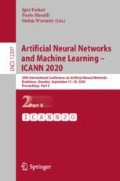Abstract
Pruning residual neural networks is a challenging task due to the constraints induced by cross layer connections. Many existing approaches assign channels connected by skip-connections to the same group and prune them simultaneously, limiting the pruning ratio on those troublesome filters. Instead, we propose a Fine-grained Channel Pruning (FCP) method that allows any channels to be pruned independently. To avoid the misalignment problem between convolution and skip connection, we always keep the residual addition operations alive. Thus we can obtain a novel efficient residual architecture by removing any unimportant channels without the alignment constraint. Besides classification, We further apply FCP on residual models for image super-resolution, which is a low-level vision task. Extensive experimental results show that FCP can achieve better performance than other state-of-the-art methods in terms of parameter and computation cost. Notably, on CIFAR-10, FCP reduces more than 78% FLOPs on ResNet-56 with no accuracy drop. Moreover, it achieves more than 48% FLOPs reduction on MSRResNet with negligible performance degradation.
Supported by the National Key R&D Program of China (2018YFB0904900, 2018YFB0904902).
Access this chapter
Tax calculation will be finalised at checkout
Purchases are for personal use only
References
Ahn, N., Kang, B., Sohn, K.-A.: Fast, accurate, and lightweight super-resolution with cascading residual network. In: Ferrari, V., Hebert, M., Sminchisescu, C., Weiss, Y. (eds.) ECCV 2018. LNCS, vol. 11214, pp. 256–272. Springer, Cham (2018). https://doi.org/10.1007/978-3-030-01249-6_16
Bevilacqua, M., Roumy, A., Guillemot, C., Alberi-Morel, M.: Low-complexity single-image super-resolution based on nonnegative neighbor embedding. In: BMVC, pp. 1–10 (2012). https://doi.org/10.5244/C.26.135
Ding, X., Ding, G., Guo, Y., Han, J.: Centripetal SGD for pruning very deep convolutional networks with complicated structure. In: CVPR, pp. 4943–4953 (2019)
Gao, S., Liu, X., Chien, L., Zhang, W., Alvarez, J.M.: VACL: variance-aware cross-layer regularization for pruning deep residual networks. CoRR abs/1909.04485 (2019). http://arxiv.org/abs/1909.04485
Han, S., Pool, J., Tran, J., Dally, W.: Learning both weights and connections for efficient neural networks, pp. 1135–1143 (2015)
He, K., Zhang, X., Ren, S., Sun, J.: Deep residual learning for image recognition. In: CVPR, pp. 770–778 (2016). https://doi.org/10.1109/CVPR.2016.90
He, Y., Kang, G., Dong, X., Fu, Y., Yang, Y.: Soft filter pruning for accelerating deep convolutional neural networks. In: IJCAI, pp. 2234–2240 (2018). https://doi.org/10.24963/ijcai.2018/309
He, Y., Liu, P., Wang, Z., Hu, Z., Yang, Y.: Filter pruning via geometric median for deep convolutional neural networks acceleration. In: CVPR, pp. 4340–4349 (2019)
He, Y., Zhang, X., Sun, J.: Channel pruning for accelerating very deep neural networks. In: ICCV, pp. 1398–1406 (2017). https://doi.org/10.1109/ICCV.2017.155
Huang, G., Liu, Z., van der Maaten, L., Weinberger, K.Q.: Densely connected convolutional networks. In: CVPR, pp. 2261–2269 (2017). https://doi.org/10.1109/CVPR.2017.243
Krizhevsky, A.: Learning multiple layers of features from tiny images. Technical report (2009)
Krizhevsky, A., Sutskever, I., Hinton, G.E.: ImageNet classification with deep convolutional neural networks. In: NeurIPS, pp. 1106–1114 (2012)
Lemaire, C., Achkar, A., Jodoin, P.: Structured pruning of neural networks with budget-aware regularization. In: CVPR, pp. 9108–9116 (2019)
Li, H., Kadav, A., Durdanovic, I., Samet, H., Graf, H.P.: Pruning filters for efficient convnets. In: ICLR (2017)
Lim, B., Son, S., Kim, H., Nah, S., Lee, K.M.: Enhanced deep residual networks for single image super-resolution. In: CVPR Workshops, pp. 1132–1140 (2017). https://doi.org/10.1109/CVPRW.2017.151
Liu, Z., Li, J., Shen, Z., Huang, G., Yan, S., Zhang, C.: Learning efficient convolutional networks through network slimming. In: ICCV, pp. 2755–2763 (2017). https://doi.org/10.1109/ICCV.2017.298
Luo, J., Wu, J., Lin, W.: ThiNet: a filter level pruning method for deep neural network compression. In: ICCV, pp. 5068–5076 (2017). https://doi.org/10.1109/ICCV.2017.541
Molchanov, P., Mallya, A., Tyree, S., Frosio, I., Kautz, J.: Importance estimation for neural network pruning. In: CVPR, pp. 11264–11272 (2019)
Simonyan, K., Zisserman, A.: Very deep convolutional networks for large-scale image recognition. In: ICLR (2015). http://arxiv.org/abs/1409.1556
Wang, X., et al.: ESRGAN: enhanced super-resolution generative adversarial networks. In: Leal-Taixé, L., Roth, S. (eds.) ECCV 2018. LNCS, vol. 11133, pp. 63–79. Springer, Cham (2019). https://doi.org/10.1007/978-3-030-11021-5_5
Wen, W., Wu, C., Wang, Y., Chen, Y., Li, H.: Learning structured sparsity in deep neural networks. In: NeurIPS. pp. 2074–2082 (2016)
You, Z., Yan, K., Ye, J., Ma, M., Wang, P.: Gate decorator: global filter pruning method for accelerating deep convolutional neural networks. In: NeurIPS, pp. 2130–2141 (2019)
Author information
Authors and Affiliations
Corresponding author
Editor information
Editors and Affiliations
Rights and permissions
Copyright information
© 2020 Springer Nature Switzerland AG
About this paper
Cite this paper
Chen, S., Huang, K., Xiong, D., Li, B., Claesen, L. (2020). Fine-Grained Channel Pruning for Deep Residual Neural Networks. In: Farkaš, I., Masulli, P., Wermter, S. (eds) Artificial Neural Networks and Machine Learning – ICANN 2020. ICANN 2020. Lecture Notes in Computer Science(), vol 12397. Springer, Cham. https://doi.org/10.1007/978-3-030-61616-8_1
Download citation
DOI: https://doi.org/10.1007/978-3-030-61616-8_1
Published:
Publisher Name: Springer, Cham
Print ISBN: 978-3-030-61615-1
Online ISBN: 978-3-030-61616-8
eBook Packages: Computer ScienceComputer Science (R0)

